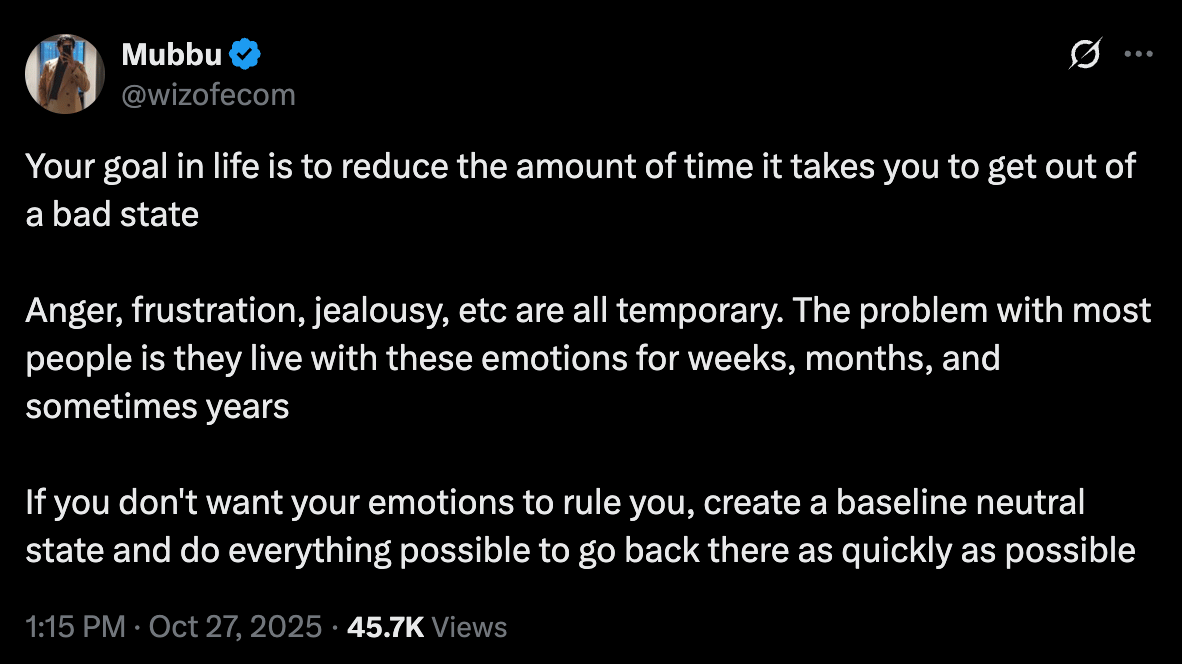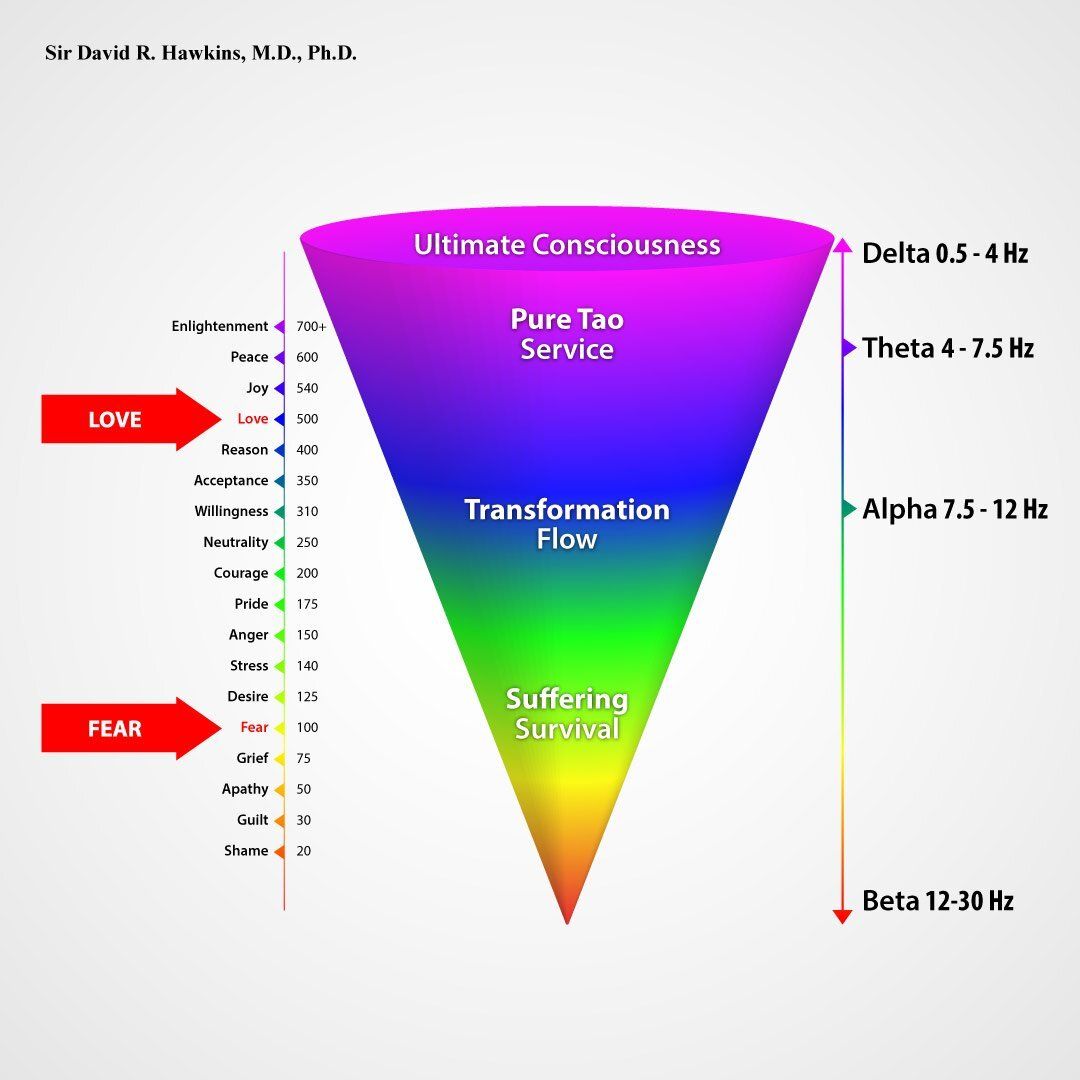- The Wizdom Newsletter
- Posts
- I don’t think you’re actually burned out
I don’t think you’re actually burned out
I think you’re just stuck in a low state. Here's how I fix it:

Recently I tweeted:

The reason the tweet blew up is because we’ve all been there.
The rage after the funnel tanks, the envy when a competitor jumps ahead, the silent shame when you promise yourself you’ll do better…
But then you don’t.
The thing most people don’t realise is that these emotions don’t just fade away.
They linger, influence your decisions and warp your energy field.
And if you stay in them too long?
Your brain rewires itself for that state of low vibration.
So how do you limit your time in those bad states?
How do you stop anger, jealousy, or frustration from hijacking your life for days at a time?
I’ve been where you are.
You tell yourself you’re “just tired” or “it’s just stress,” but if you zoom out, it’s the same loop playing over and over. And it’s costing you more than you realize.
Because when your mind is hijacked by emotion, you make worse business decisions > You rush offers > You ruin conversations > You self-sabotage momentum.
A while back, my performance coach, Leon Castillo, said something I’ll never forget:
“The goal isn’t to avoid negative emotion. It’s to shorten the time you live inside it.”
That changed everything.
He taught me to stop judging emotions as good or bad and start treating them as signals.
They arrive > They have a message > Then they’re meant to leave.
But most people never let them go. They turn the emotion into their identity.
“Anger” becomes who they are.
“Frustration” becomes the lens through which they see everything.
“Jealousy” becomes the background noise of their day.
I’ve been studying this for a while.
And one of the frameworks I keep returning to is Power vs. Force by David R. Hawkins in which he maps emotional states on a spectrum of consciousness: from Fear, Anger, Pride…up to Courage, Acceptance, Peace.
If you haven’t seen this before:

In his model, when you operate below 200 (on his scale), you’re in “force” which is reactive, desperate, low‑leverage. Above 200 starts real power.
Most people spend their lives oscillating between anger, pride, and desire and think that’s “normal.” But these are just different shades of resistance.
The goal isn’t to live in constant happiness, that’s just another high that fades. The goal is to find neutrality.
This matters in business too.
Once I accepted this truth, I stopped treating growth like purely a numbers game and started treating it like an emotional game.
I began tracking my states:
Foggy mornings where replying to Slack felt like replying with lead weights
The days when envy snuck into my feed‑scroll and I didn’t notice
The weeks I allowed doubt to linger and make decisions for me
And then I started the reverse:
Notice the moment I catch myself being reactive
Pause and ask: What am I feeling? Why am I feeling it?
Return to a baseline neutral state while avoiding a rush or drama
Then decide: What action makes sense from this place?
When you operate from the neutral baseline, the one where you’re clear, present, not hijacked by emotion, you make better decisions, faster.
How to Return to Neutral
1. Radical Self-Honesty
Hawkins calls this “the first doorway to higher consciousness.” Every emotion is trying to tell you something. Instead of suppressing it, ask:
→ What truth am I avoiding here?
→ What part of me feels threatened?
→ What story am I replaying that no longer serves me?
2. Don’t Resist What You Feel
The more you resist emotion, the more power it gains. Feel it. Label it. Watch it move through you.
The energy of emotion literally dissipates when observed without judgment.
It’s physics. (Energy = emotion in motion.)
3. Anchor Back to the Baseline
Create rituals that pull you back to center.
For me, these are practices like breathwork, journaling, walking, and silence.
For you, it might be prayer, music, or a quick reset in sunlight.
Whatever it is, make it your return path.
Your job isn’t to stay calm 24/7. That’s going to set you up for failure and leave you disappointed because it’s unrealistic to always be guarding yourself. You need to have practices that help you find your way back (faster each time).
4. Detach From the Story
When you’re triggered, it’s easy to start forming narratives:
> “They don’t respect me.”
> “This launch failed because I’m not good enough.”
No. That’s ego talking. Detach from the storyline. Focus on the state.
Fix the signal.
The reason this matters for you and your business or even if you’re at a 9-5 is you’ve got to be able to navigate the storms.
The people who can manage their own nervous‑systems are the ones who get 2x the leverage with ½ the effort because:
> You don’t panic‑optimize when a funnel stalls
> You don’t settle for half results out of frustration
> You don’t let jealousy steal your clarity
You stay calm through it all and make good decisions.
Learning to control your inner world is the first step to mastering the outer one.
–Wiz
If you’re trying to grow a personal brand that attracts real opportunity, here are 2 ways I can help:
→ Build your personal brand with Utopia if you want to DIY
→ If you're already running a 6/7/8-figure business and want to delegate content with conviction, we help founders like you become micro-authorities in your space. Apply to work with us